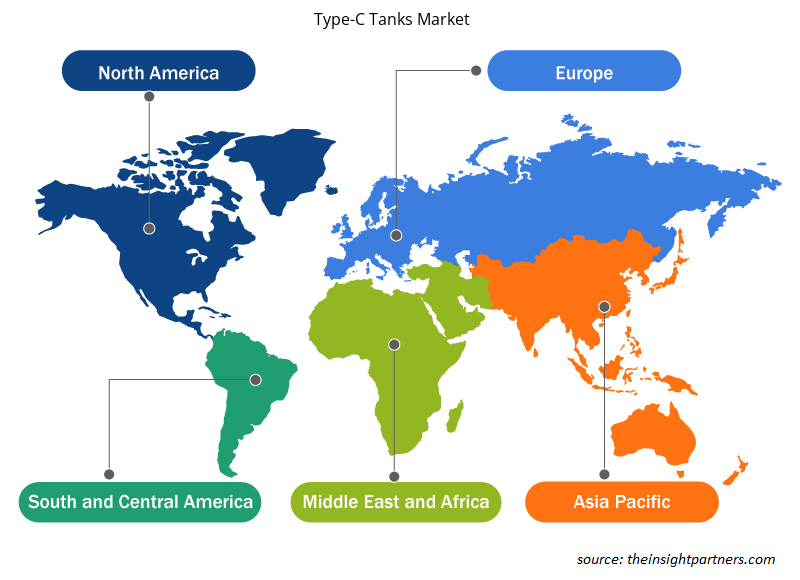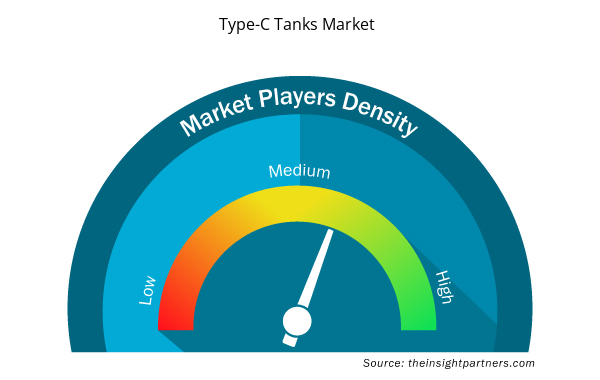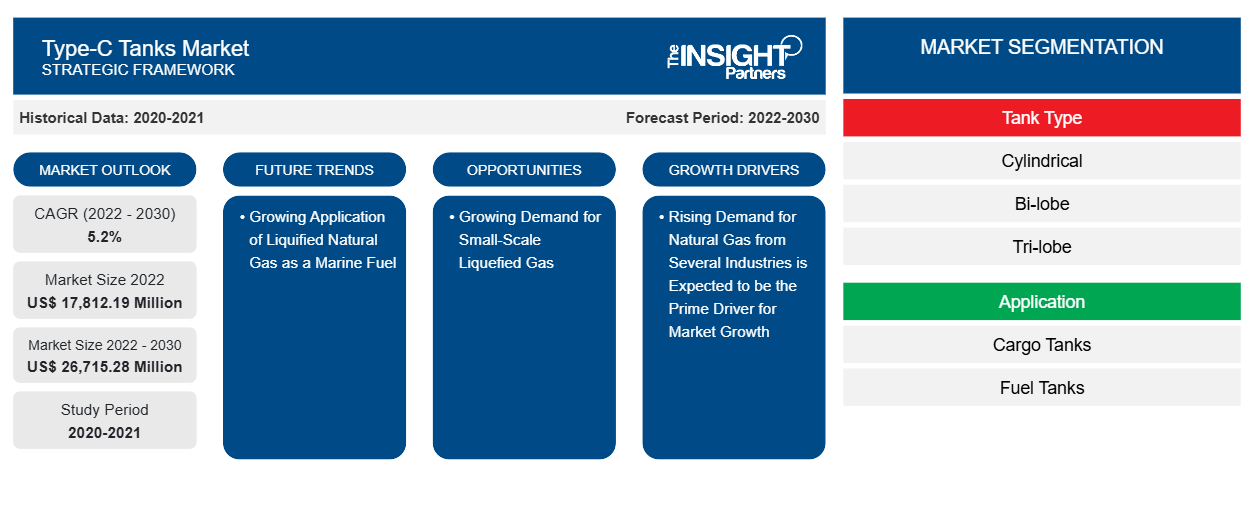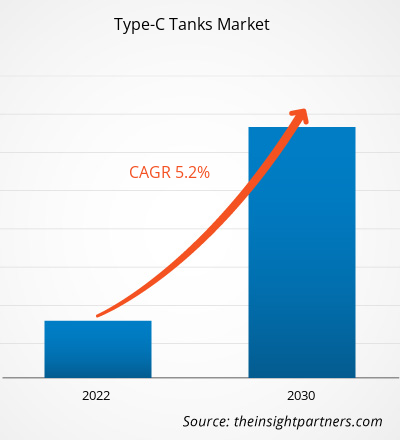C 型油箱市场规模预计将从 2022 年的 178.1219 亿美元增至 2030 年的 267.1528 亿美元。预计 2022-2030 年市场复合年增长率为 5.2%。
天然气还用于制造纸张、砖块、玻璃、钢铁和铁,是一种廉价的替代品。人们对高容量和廉价能源的日益偏爱推动了天然气的应用。例如,2023 年 9 月,印度的天然气消费量为 52.54 亿标准立方米。由于化肥行业的发展,预计到 2026 年,印度的天然气需求将增长 8% 以上。此外,根据美国能源信息署的数据,预计 2023 年和 2024 年美国的天然气产量和需求将增加。预计 2023 年美国天然气产量将达到 1036.8 亿立方英尺/天,到 2024 年将达到 1051.2 亿立方英尺/天,高于 2022 年美国的 996 亿立方英尺/天。因此,预计液化天然气消费量的增加将推动 C 型储罐市场在预测期内的增长。在可行的预测期内,最终用户(包括陆基工业、发电厂以及作为车辆或船舶燃料的 LNG 供应商)对小规模 LNG 运输的需求正在增加。因此,预计这种不断增长的需求将对 C 型储罐市场产生积极影响。
C 型储罐市场分析
C 型油箱市场的主要终端用户包括船舶、石油和天然气、石化和其他工业应用。天然气作为工业和家庭的清洁化石燃料的使用日益增多,这意味着全球液化天然气 (LNG) 的供应是一种有利可图的趋势。因此,航运公司、石油和天然气公司以及石化公司正在战略性地选择多元化发展液化天然气船队。终端使用行业越来越多地采用 C 型油箱,从而进一步利用预测时间范围内的市场动态。
C 型储罐市场概况
天然气广泛应用于多种工业领域。例如,它可用作热电联产系统中的工艺加热燃料、制造化学品、肥料和氢气的原材料(原料)以及租赁和工厂燃料。天然气还用于废物处理和焚烧应用、干燥和除湿、金属和采矿业中的金属预热、玻璃熔化、食品加工和工业锅炉燃料。丁烷、乙烷、丙烷和一些其他气体也可从天然气中获得,天然气可用作药品和肥料的原料。工业部门的发展预计将使工业应用领域的液化天然气消费量激增。
定制此报告以满足您的需求
您可以免费定制任何报告,包括本报告的部分内容、国家级分析、Excel 数据包,以及为初创企业和大学提供优惠和折扣
- 获取此报告的关键市场趋势。这个免费样品将包括数据分析,从市场趋势到估计和预测。
C 型储罐市场驱动因素和机遇
预计各行业对天然气的需求增长将成为市场增长的主要动力
航运和卡车运输业对比柴油和石油更环保的燃料的需求不断增长,这导致对小型液化气的需求激增。小型液化气适用于短途至中途运输,特别是国内贸易。小型液化气的应用日益广泛,这是推动独立 C 型围护系统或储罐使用率上升的有希望的因素之一,这些系统或储罐通常用于小型液化气货物运输。例如,对于双叶 C 型 LPG/LNG/LEG 船,运输船内可能安装有四个双叶储罐,每个储罐都有端部鞍形支撑。一端和另一端主要设计为纵向滑动,以平衡储罐温度变化引起的热收缩或膨胀的影响。此外,在偏远地区,管道不可行或不经济。
小型液化气需求不断增长
航运和卡车运输行业对比柴油和石油更环保的燃料的需求不断增长,这导致对小型液化气的需求激增。小型液化气适用于短距离至中距离运输,特别是国内贸易。小型液化气的应用日益广泛,这是推动使用独立 C 型围护系统或储罐的有希望的因素之一,这些系统或储罐通常用于小型液化气货物运输。例如,对于双叶 C 型 LPG/LNG/LEG 船,运输船内可能安装有四个双叶储罐,每个储罐都有端部鞍形支撑。一端和另一端主要设计为纵向滑动,以平衡储罐温度变化引起的热收缩或膨胀的影响。此外,在偏远地区,管道不可行或经济上不可行,包括陆上工业、发电厂和作为车辆或船舶燃料的 LNG 供应商在内的终端用户对小型液化天然气运输的需求正在增加。因此,预计这种不断增长的需求将对 C 型油箱市场产生积极影响。
C 型储罐市场报告细分分析
有助于得出C 型油箱市场分析的关键部分是油箱类型、应用和最终用户。
- 根据储罐类型,市场分为圆柱形、双叶形、三叶形。圆柱形部分在 2022 年占据了较大的市场份额。
- 根据应用,全球 C 型油箱市场分为货油箱、油箱。2022 年,油箱部分占据了较大的市场份额。
- 根据最终用户,全球市场分为液化天然气、液化石油气、液化氢气和乙醇。液化石油气领域在 2022 年占据了更大的市场份额。
C 型储罐市场份额按地区分析
C 型储罐市场报告的范围涵盖北美(美国、加拿大和墨西哥)、欧洲(西班牙、英国、德国、法国、意大利和欧洲其他地区)、亚太地区(韩国、中国、印度、日本、澳大利亚和亚太地区其他地区)、中东和非洲(南非、沙特阿拉伯、阿联酋和中东和非洲其他地区)以及南美洲和中美洲(巴西、阿根廷和南美洲和中美洲其他地区)。就收入而言,亚太地区在 2023 年占据了 C 型储罐市场份额的主导地位。欧洲是全球 C 型储罐市场的第二大贡献者,其次是北美。
C 型储罐市场区域洞察
Insight Partners 的分析师已详细解释了预测期内影响 C 型储罐市场的区域趋势和因素。本节还讨论了北美、欧洲、亚太地区、中东和非洲以及南美和中美洲的 C 型储罐市场细分和地理位置。

- 获取 C 型油箱市场的区域特定数据
C 型储罐市场报告范围
| 报告属性 | 细节 |
|---|---|
| 2022 年市场规模 | 178.1219亿美元 |
| 2030 年的市场规模 | 267.1528亿美元 |
| 全球复合年增长率(2022 - 2030 年) | 5.2% |
| 史料 | 2020-2021 |
| 预测期 | 2022-2030 |
| 涵盖的领域 | 按坦克类型
|
| 覆盖地区和国家 | 北美
|
| 市场领导者和主要公司简介 |
|
C 型储罐市场参与者密度:了解其对业务动态的影响
由于消费者偏好的不断变化、技术进步以及对产品优势的认识不断提高等因素,最终用户需求不断增加,推动了 C 型储罐市场快速增长。随着需求的增加,企业正在扩大其产品范围,进行创新以满足消费者需求,并利用新兴趋势,从而进一步推动市场增长。
市场参与者密度是指在特定市场或行业内运营的企业或公司的分布情况。它表明在给定市场空间中,相对于其规模或总市场价值,有多少竞争对手(市场参与者)存在。
在 C 型储罐市场运营的主要公司有:
- MAN Energy Solutions Sverige AB
- 燃气和热能公司
- 中国国际海运集装箱
- 中船澄西(泰州)
- 瓦茨能源
免责声明:上面列出的公司没有按照任何特定顺序排列。

- 获取 Type-C 油箱市场主要参与者概览
C 型储罐市场新闻和最新发展
通过收集主要和次要研究后的定性和定量数据来评估 C 型储罐市场,其中包括重要的公司出版物、协会数据和数据库。以下是 C 型储罐市场的发展和战略列表:
- 2023 年 6 月,中集安瑞科旗下南通太平洋海洋工程有限公司(中集太平洋)与 Avance Gas 签订了 2+2 艘中型液化气船订单,价值近 9 亿元人民币。这是中集太平洋首次承接 40,000 立方米 LPG 液氨船建造订单,标志着中集中小型液化气船的设计和建造能力进一步提升。(来源:中集太平洋,新闻稿/公司网站/通讯)
- 2024 年 2 月,Adani Total Gas Ltd 签署了一项相互支持协议,根据该协议,ATGL 和 INOXCVA 将相互授予“优先合作伙伴”地位,以交付 LNG 和 LCNG 设备和服务,以确定和探索可能的合作机会,以加强该国的 LNG生态系统。作为优先合作伙伴,ATGL 将拥有某些固有的项目层面优势,包括对 ATGL 的优惠待遇和提前调度的权利,以及考虑建立 LNG/LCNG 站、LNG 卫星站、过渡到 LNG 作为运输燃料、LNG 物流以及为该行业开发小规模液氢解决方案的合作机会。(来源:Adani Total Gas Ltd,新闻稿/公司网站/时事通讯)
C 型储罐市场报告覆盖范围和交付成果
“C 型储罐市场规模和预测(2020-2030 年)”报告对以下领域进行了详细的市场分析:
- 范围内涵盖的所有主要细分市场的全球、区域和国家层面的市场规模和预测
- 市场动态,如驱动因素、限制因素和关键机遇
- 未来主要趋势
- 详细的波特五力分析
- 全球和区域市场分析涵盖关键市场趋势、主要参与者、法规和最新市场发展
- 行业格局和竞争分析,涵盖市场集中度、热点图分析、知名参与者和最新发展
- 带有 SWOT 分析的详细公司简介
- 历史分析(2 年)、基准年、预测(7 年)及复合年增长率
- PEST 和 SWOT 分析
- 市场规模价值/数量 - 全球、区域、国家
- 行业和竞争格局
- Excel 数据集



Report Coverage
Revenue forecast, Company Analysis, Industry landscape, Growth factors, and Trends

Segment Covered
This text is related
to segments covered.

Regional Scope
North America, Europe, Asia Pacific, Middle East & Africa, South & Central America

Country Scope
This text is related
to country scope.
Trends and growth analysis reports related to Manufacturing and Construction : READ MORE..
The Insight Partners performs research in 4 major stages: Data Collection & Secondary Research, Primary Research, Data Analysis and Data Triangulation & Final Review.
- Data Collection and Secondary Research:
As a market research and consulting firm operating from a decade, we have published and advised several client across the globe. First step for any study will start with an assessment of currently available data and insights from existing reports. Further, historical and current market information is collected from Investor Presentations, Annual Reports, SEC Filings, etc., and other information related to company’s performance and market positioning are gathered from Paid Databases (Factiva, Hoovers, and Reuters) and various other publications available in public domain.
Several associations trade associates, technical forums, institutes, societies and organization are accessed to gain technical as well as market related insights through their publications such as research papers, blogs and press releases related to the studies are referred to get cues about the market. Further, white papers, journals, magazines, and other news articles published in last 3 years are scrutinized and analyzed to understand the current market trends.
- Primary Research:
The primarily interview analysis comprise of data obtained from industry participants interview and answers to survey questions gathered by in-house primary team.
For primary research, interviews are conducted with industry experts/CEOs/Marketing Managers/VPs/Subject Matter Experts from both demand and supply side to get a 360-degree view of the market. The primary team conducts several interviews based on the complexity of the markets to understand the various market trends and dynamics which makes research more credible and precise.
A typical research interview fulfils the following functions:
- Provides first-hand information on the market size, market trends, growth trends, competitive landscape, and outlook
- Validates and strengthens in-house secondary research findings
- Develops the analysis team’s expertise and market understanding
Primary research involves email interactions and telephone interviews for each market, category, segment, and sub-segment across geographies. The participants who typically take part in such a process include, but are not limited to:
- Industry participants: VPs, business development managers, market intelligence managers and national sales managers
- Outside experts: Valuation experts, research analysts and key opinion leaders specializing in the electronics and semiconductor industry.
Below is the breakup of our primary respondents by company, designation, and region:

Once we receive the confirmation from primary research sources or primary respondents, we finalize the base year market estimation and forecast the data as per the macroeconomic and microeconomic factors assessed during data collection.
- Data Analysis:
Once data is validated through both secondary as well as primary respondents, we finalize the market estimations by hypothesis formulation and factor analysis at regional and country level.
- Macro-Economic Factor Analysis:
We analyse macroeconomic indicators such the gross domestic product (GDP), increase in the demand for goods and services across industries, technological advancement, regional economic growth, governmental policies, the influence of COVID-19, PEST analysis, and other aspects. This analysis aids in setting benchmarks for various nations/regions and approximating market splits. Additionally, the general trend of the aforementioned components aid in determining the market's development possibilities.
- Country Level Data:
Various factors that are especially aligned to the country are taken into account to determine the market size for a certain area and country, including the presence of vendors, such as headquarters and offices, the country's GDP, demand patterns, and industry growth. To comprehend the market dynamics for the nation, a number of growth variables, inhibitors, application areas, and current market trends are researched. The aforementioned elements aid in determining the country's overall market's growth potential.
- Company Profile:
The “Table of Contents” is formulated by listing and analyzing more than 25 - 30 companies operating in the market ecosystem across geographies. However, we profile only 10 companies as a standard practice in our syndicate reports. These 10 companies comprise leading, emerging, and regional players. Nonetheless, our analysis is not restricted to the 10 listed companies, we also analyze other companies present in the market to develop a holistic view and understand the prevailing trends. The “Company Profiles” section in the report covers key facts, business description, products & services, financial information, SWOT analysis, and key developments. The financial information presented is extracted from the annual reports and official documents of the publicly listed companies. Upon collecting the information for the sections of respective companies, we verify them via various primary sources and then compile the data in respective company profiles. The company level information helps us in deriving the base number as well as in forecasting the market size.
- Developing Base Number:
Aggregation of sales statistics (2020-2022) and macro-economic factor, and other secondary and primary research insights are utilized to arrive at base number and related market shares for 2022. The data gaps are identified in this step and relevant market data is analyzed, collected from paid primary interviews or databases. On finalizing the base year market size, forecasts are developed on the basis of macro-economic, industry and market growth factors and company level analysis.
- Data Triangulation and Final Review:
The market findings and base year market size calculations are validated from supply as well as demand side. Demand side validations are based on macro-economic factor analysis and benchmarks for respective regions and countries. In case of supply side validations, revenues of major companies are estimated (in case not available) based on industry benchmark, approximate number of employees, product portfolio, and primary interviews revenues are gathered. Further revenue from target product/service segment is assessed to avoid overshooting of market statistics. In case of heavy deviations between supply and demand side values, all thes steps are repeated to achieve synchronization.
We follow an iterative model, wherein we share our research findings with Subject Matter Experts (SME’s) and Key Opinion Leaders (KOLs) until consensus view of the market is not formulated – this model negates any drastic deviation in the opinions of experts. Only validated and universally acceptable research findings are quoted in our reports.
We have important check points that we use to validate our research findings – which we call – data triangulation, where we validate the information, we generate from secondary sources with primary interviews and then we re-validate with our internal data bases and Subject matter experts. This comprehensive model enables us to deliver high quality, reliable data in shortest possible time.


 获取此报告的免费样本
获取此报告的免费样本